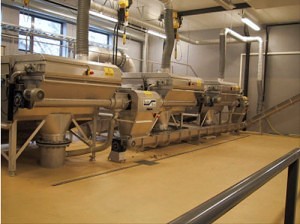General Performance
Depending on the influent concentrations the concentration of suspended solids can be reduced by 40-70%. The removed solids can be dewatered to 25 to 45% dry solids.
Performance at specific installations
 The performance of the Salsnes Filter fine mesh sieves has been tested at the WWTP Tiendeholmen in Namsos, Norway. The plant is designed for 22.500 population equivalents and a maximum flow of 1080 m3/h. The treatment system is made up of coarse screens and sand traps, followed by two Salsnes Filter fine mesh sieves in parallel. The two sieves treat equal amounts of wastewater. The effluent from the fine mesh sieves is discharged to the ocean. During the test, one sieve had a wire mesh cloth with 0.3 mm mesh size. The other sieve had a wire mesh cloth with 0.35 mm mesh size. The test lasted from July, 11 through August 24, 2000. The requirements for primary treatment were fulfilled, defined as 50 % removal of SS and 20 % removal of BOD5. Average removal efficiencies were 59 % for SS, 45 % for COD and 36 % for BOD5. The primary sludge leaving the sieves had an average dry solids concentration of 23 %.
The performance of the Salsnes Filter fine mesh sieves has been tested at the WWTP Tiendeholmen in Namsos, Norway. The plant is designed for 22.500 population equivalents and a maximum flow of 1080 m3/h. The treatment system is made up of coarse screens and sand traps, followed by two Salsnes Filter fine mesh sieves in parallel. The two sieves treat equal amounts of wastewater. The effluent from the fine mesh sieves is discharged to the ocean. During the test, one sieve had a wire mesh cloth with 0.3 mm mesh size. The other sieve had a wire mesh cloth with 0.35 mm mesh size. The test lasted from July, 11 through August 24, 2000. The requirements for primary treatment were fulfilled, defined as 50 % removal of SS and 20 % removal of BOD5. Average removal efficiencies were 59 % for SS, 45 % for COD and 36 % for BOD5. The primary sludge leaving the sieves had an average dry solids concentration of 23 %.
Operational stability and maintenance
A pressure transmitter/controller measures the level of the incoming water and adjusts the speed of the cloth. Thus, a high filter efficiency can be achieved under varied flows conditions and SS concentrations. The SF is completely automatic, including the cleaning system and requires a minimum of maintenance. For maintenance of the cloth, it is flushed by hot water twice a day (2 x 20l). The filter units are completely closed facilitating ventilation and odour control.
Operating Costs
The feasibility of using the fine mesh sieves (with 0.3 mm mesh size) instead of conventional sedimentation for primary treatment of municipal wastewater, was evaluated for a generic treatment plant with an average flow of 18.000 m3/d. The study was carried out by a Norwegian research institute, aquateam.
Flow sheets for four different process combinations were presented, covering primary treatment only, and primary treatment followed by a nitrifying activated sludge plant. The different unit processes and reactors were designed and dimensioned based on given criteria, and finally the total cost and area requirement for a process, or the difference in cost and area requirement between processes, were calculated for each alternative. The cost comparisons were made for outdoor plants with open basins. The cost for land was set at zero.
For primary treatment only, the fine mesh sieves needed less than 10 % of the area required for conventional sedimentation, and the investment cost was about 50 % of the cost for conventional sedimentation. For primary treatment including thickening and dewatering, the fine mesh sieves were also expected to save 12.500 euro/year in operating cost.
For plants without thickening and dewatering, the operating costs were somewhat lower for sedimentation than for the fine mesh sieves. The reason for this is that dewatering is an integral part of the sieves, and that the energy consumption for operation of the sieves is higher than the energy consumption necessary for the operation of sludge pumps and scrapers in a conventional sedimentation process.
For primary treatment followed by nitrifying activated sludge, usage of Salsnes Filter fine mesh sieves will save about 440.000 euro in investment. Due to the large savings in investment costs, application of sieves will result in significantly reduced annual costs (capital plus operating costs) for all alternatives considered. Considering the use of covered reactors and costs for land, it is expected that the application of fine mesh sieves will result in even larger savings [3].
